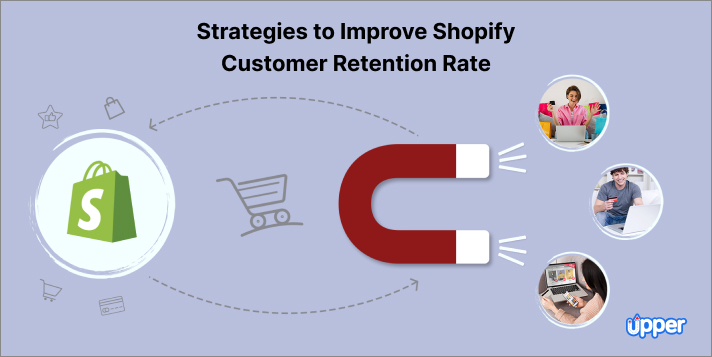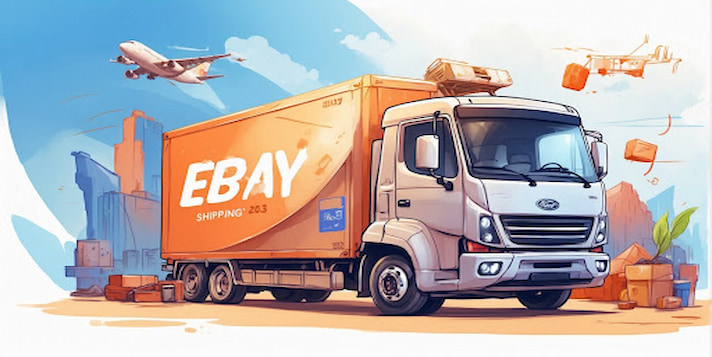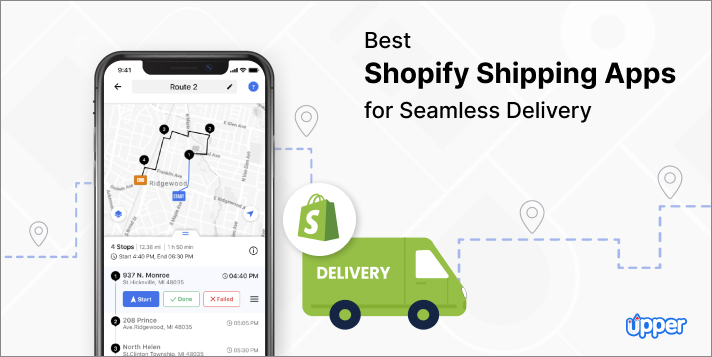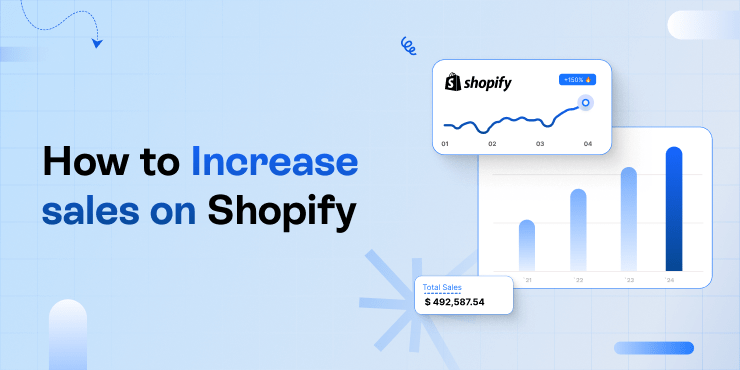 Key Takeaways:
Key Takeaways:
- Customer retention is not just a metric, rather it’s a cornerstone that impacts profitability, credibility, and sustainability of your business.
- The metrics to measure customer retention include, repeat customer rate, purchase frequency, average order value, customer lifetime value, and churn rate.
- Diverse strategies can be implemented to retain Shopify customers, including personalized experiences, email marketing, loyalty programs, and so on.
- Beware of common challenges that can hamper your Shopify customer retention such as neglecting personalization, delayed responses to customers, or ignoring their feedback.
eCommerce is a thriving marketplace, where the competition is fierce and shoppers have endless choices. The real magic lies in transforming one-time customers into loyal brand advocates. Amid this, earning and retaining customer loyalty is the true crown.
As per reports of Harvard Business School, business profit can be increased from 25% to 95% by improving customer retention by 5%. Hence, enhancing customer loyalty not only boosts profitability but also establishes a foundation for sustainable growth.
Are you also running an eCommerce store and curious about how to retain customers? In this article, we’ll share 10 strategies for Shopify customer retention. So, let’s get started.
Forget Spaghetti Routes, Optimize Routes for Your Entire Team with Upper
Start a 7-Day Free Trial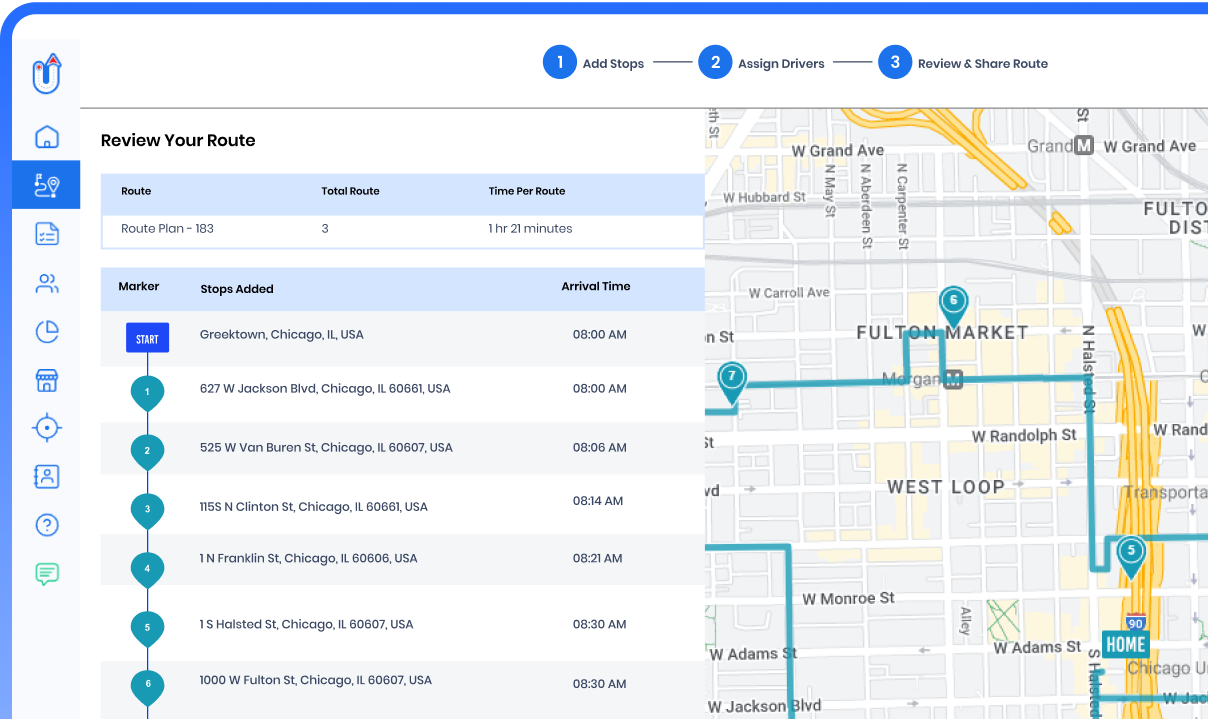
Table of Content
What is Customer Retention?
Customer retention is the art of keeping existing clients engaged and fulfilled, empowering them to make repeat purchases from your business. It gives critical insights into product quality, service satisfaction, repeat purchase rates, and areas for improvement.
To encourage client retention, organizations should focus on upgrading consumer loyalty through different strategies and tactics. By doing so, they plan to create a positive client experience, sustain commitment, and guarantee that clients stay steadfast in their loyalty to your brand.
Formula to calculate customer retention rate
Importance of Customer Retention
Lifting your Shopify customer retention rate isn’t just a strategy; it’s a pivotal factor that can shape the fate of your online business.
- Profitability: Loyal customers will generally make more purchases over time, subsequently expanding your client’s lifetime value, which is a key driver of a business’s profitability.
- Cost efficiency: Customer retention is a savvy technique, as it’s generally more costly to get new clients than to hold existing ones. By focusing on keeping your current customers engaged, you decrease the need for costly acquisition endeavors.
- Steady revenue: Keeping a loyal customer base gives your business a predictable and more dependable income.
- Word of mouth: Loyal customers do not simply stay connected to you but they also become brand advocates. Their positive experiences lead to word-of-mouth referrals, drawing in new clients.
- Brand credibility: Building a strong base of steadfast clients improves your brand’s credibility and reliability, further supporting your brand’s reputation.
Hence, customer retention remains the bedrock of success, shaping profitability, operational efficiency, and the enduring credibility of your brand.
Top 10 Strategies for Shopify Customer Retention Success
Customer retention is the soul of any Shopify store’s long-term success. To ensure your customers keep coming back, it’s crucial to implement effective strategies that enhance their shopping experience.
Here are the top 10 strategies to transform one-time customers into faithful, long-lasting fans:
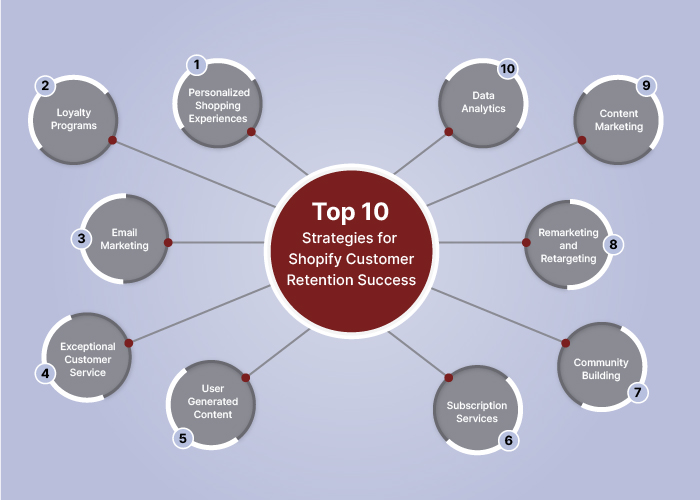
1. Personalized shopping experiences
Personalization is the key to winning customer loyalty. By analyzing client information and behavior, you can recommend products customized to their preferences. Show them items related to their past purchases or what’s trending among similar shoppers. The better you understand your clients’ needs, the more likely they are to come back.
Beyond product recommendations, consider personalizing emails, website content, and even your checkout process. You can also address customers by name, send customized offers, and create a remarkable shopping experience for the customers.
You might also consider integrating the route app into your Shopify store to offer customers a seamless experience. This combination of personalization, impeccable delivery, and package security collectively influences Shopify customer retention.
2. Loyalty programs
Loyalty programs are a tried and tested way to keep your customers engaged. Create a reward system that boosts repeat purchases and client interactions. Additionally, discounts or exclusive access can propel clients to get back to your store.
You need to make sure that the rewards you are offering are significant to your client base.
The reason is that as customers accumulate rewards, they’ll feel more associated with your brand. They’ll keep on shopping with you as well as become advocates, imparting their positive experiences to other people.
3. Email marketing
Email marketing is an amazing tool for keeping clients locked in. You can send customized messages with item proposals, offers, and updates about their favorite items. Additionally, you can use division to target explicit client groups and send them the relevant emails.
Abandoned cart emails, post-purchase follow-ups, and newsletters are successful ways of keeping in touch with your clients. The key is to offer some incentive and significance with each email, keeping your brand top-of-mind.
4. Exceptional customer service
Offering exceptional customer service is non-debatable for customer retention, irrespective of any business. You must focus on quickly addressing client requests and resolving them. Whether it’s an inquiry regarding an item or help with a return, the client ought to feel esteemed and heard.
You can also consider incorporating Upper’s Shopify local delivery app to manage deliveries efficiently, ensuring timely and hassle-free customer interactions. This could help in holding clients as well as transforming them into faithful brand advocates. Satisfied clients are bound to recommend your store to others, contributing to organic growth.
5. User-generated content
Urge customers to leave reviews, ratings, and testimonials about your products and services. This user-generated content adds authenticity and trustworthiness to your brand image. It helps them to make informed decisions and builds a sense of community around your products.
You can also consider organizing contests or campaigns to encourage customers to share their experiences on social media. As user-generated content can go a long way in spreading the word about your brand.
6. Subscription services
Subscription services are an incredible way to get secured income and build client loyalty for your Shopify store. You can offer subscription offers for items that clients buy frequently, for example, daily consumables or personal care items.
Subscribers enjoy the convenience of regular deliveries, and you benefit from predictable, recurring revenue. Furthermore, membership clients will quite often be more faithful, as they’ve focused on regular purchases.
7. Community building
Cultivate a sense of community among your clients. This can be achieved by creating forums, social groups, or online communities where clients talk about their experiences, ask questions, and share insights.
Building a community keeps clients connected as well as gives significant criticism and insights. It’s an excellent way to make a loyal customer base that feels a strong connection with your brand.
8. Remarketing and retargeting
Numerous clients might visit your store without making a purchase. To reconnect with these expected clients, utilize computerized advertising techniques like remarketing and retargeting.
Also, you can offer targeted promotions to clients who have recently visited your site yet haven’t made any purchases. Additionally, feature items they saw, abandoned cart items, or extraordinary offers. This keeps your brand image on their radar and can prompt conversions.
9. Content marketing
Content marketing includes creating informative and engaging content that resonates with your target audience. Some of the ways to educate and engage your clients include sharing blog posts, videos, and articles.
Additionally, content marketing enhances your brand’s credibility and encourages customers to return thus boosting customer retention for your Shopify store.
10. Data analytics
Leverage data analytics to track and measure key customer retention metrics. Break down client conduct, inclinations, and patterns to distinguish what works and what doesn’t.
With data-driven insights you can constantly refine your strategies, zeroing in on what drives client dedication and commitment. Last but not least, data analytics is the compass that directs your customer retention endeavor.
These 10 customer retention strategies serve as your guide to long-term success, where profitability and customer loyalty go hand in hand.
Key Metrics for Customer Retention
Customer retention metrics are key performance indicators (KPIs) used to assess and track the viability of your client retention endeavors. Some common customer retention metrics include:
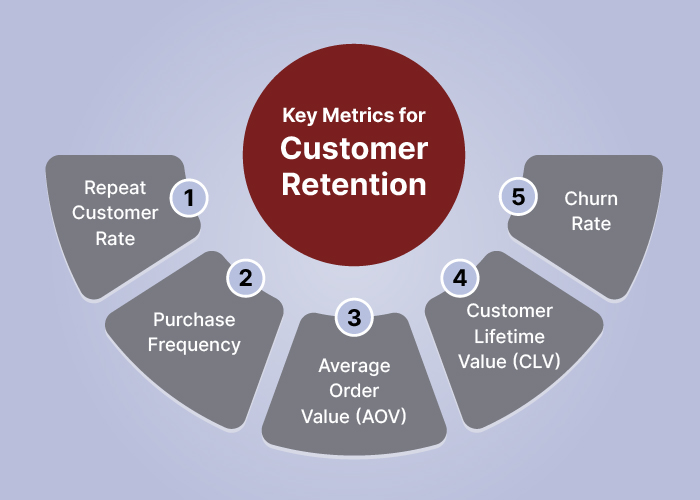
1. Repeat customer rate
Repeat customer rate is the foundation of customer retention. It estimates the percentage of clients willing to make a second purchase from you. Measuring your recurrent buy rate is a superb approach to assessing how well your retention strategy is working. The higher this metric is, the more willing clients are to get back to your store.
Here’s how to calculate the repeat purchase rate:
Number of customers that purchased more than once / Number of unique customers
2. Purchase frequency
Purchase frequency shows you how frequently clients are returning to purchase from your store. This is particularly significant when you consider that recurrent clients are often responsible for your store’s annual revenue. However, this can vary depending on the product category.
Here’s how to calculate the purchase frequency:
Number of orders placed / Number of unique customers
3. Average order value (AOV)
When you comprehend repeat purchase rate and purchase frequency, now is the right time to boost how much each of those purchases is worth. This metric is known as average order value and alludes to how much cash a client spends in your store on every transaction.
Very much like purchase frequency, your average order value ought to be determined utilizing a similar time you set for your repeat purchase rate.
Here’s how to find out the average order value:
Total revenue earned in a given time / Number of orders placed
4. Customer Lifetime Value (CLV)
Customer lifetime value is the total revenue you can expect to procure over the lifetime of your relationship with a client. Customer lifetime value (CLV) can be calculated using the below formula:
Purchase Frequency x Average Order Value
5. Churn rate
The customer churn rate is the percentage of clients who’ve quit being your clients during some random period. There could be various reasons behind increasing your client churn rate, such as:
- Client expectations weren’t met (bad experience with product or client support)
- Found a cheaper or better alternative
- If it’s a subscription service, their payment method could have expired
- Network failures
Number of customers at a certain period – Number of customers at the end of a period / Number of customers at the beginning of that period
In this way, tailoring metrics to your particular business goals and industry is essential for a powerful customer retention strategy.
FAQs
Here is a list of factors that can affect customer retention:
- Ease of use and convenience
- Customer satisfaction
- Quality of products
- Brand reputation
- Customer support
- Competitive pricing
A healthy customer retention rate normally falls between 20% to 40%. However, the ideal rate can vary depending on your specific industry dynamics and eCommerce business model.
Success can be measured through key performance indicators (KPIs) like the customer retention rate, customer lifetime value, repeat purchase rate, and Net Promoter Score (NPS). Consistently analyzing these metrics and comparing them over the long run will give insights into the viability of your client retention techniques.
Some of the common challenges in customer retention for Shopify stores include:
- Fierce competition
- Customer trust
- Personalized shopping experience
- Consistent customer engagement
The key mistakes to avoid in customer retention on Shopify can be:
- Neglecting personalization
- Delayed customer responses
- Ignoring customer feedback
- Inconsistent engagement
Conclusion
To sum up, the eCommerce journey doesn’t finish at the place of checkout. It extends far beyond and into the domain of customer retention- the mystery ingredient of sustained success. By executing these strategies, you secure profitability and operational efficiency as well as solidify your brand’s credibility.
Customer retention is an ongoing effort that requires a continuous connection, tailored experiences, and exceptional service to gain long-lasting customers. Thus, embrace these strategies and watch your Shopify store flourish.
